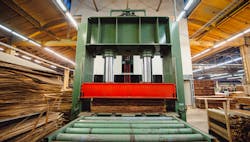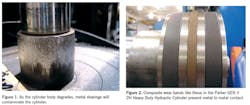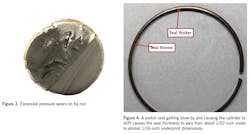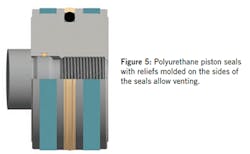A cylinder failure can lead to costly downtime or safety issues that could be hazardous to your business and your employees. The reality is that cylinders can fail for a number of reasons. However, in this day and age with a number of engineering tools available to help reduce spec errors and strong expertise within the fluid power industry, the leading causes of cylinder failure will tend to come from side loading, excessive pressure, sealing issues, or improper tie rod torque. An unforeseen or miscalculated force outside the cylinder, pressure above cylinder rating, an improperly specified or installed seal, or a poorly maintained tie rod can all cause cylinder problems.
Side loading problems and solutions
Side loading occurs when the piston rod is forced into the rod gland. This will create localized deterioration on one side of the bearing leading to misalignment of the cylinder. This misalignment can force the piston into the cylinder body, causing materials to wear. As the body degrades, metal shavings will contaminate the cylinder (see Figure 1), which will lead to improper pressures on either side of the piston, eventually leading to failure.
This can be combated with composite wear bands that prevent metal-to-metal contact and increase the cylinder’s tolerance to side loading (see Figure 2). Wear bands provide good resistance to contamination, helping cylinders operate more efficiently and lowering the likelihood of failure due to side loading.
Excessive pressure concerns
Pressure above the cylinder rating produces increased forces and excessive loads on the tie rods. These excessive loads can cause the tie rods to stretch or break. This allows the end caps to separate from the cylinder body, leading to end body seal failure. Most standard cylinders and components, including seals and hard parts, are generally rated to a max of 3,000 psi. Pressure in excess of this will cause failure (see Figure 3). Cylinders exposed to pressures in excess of their rated envelope pressure must be engineered to operate under those conditions. Always ensure you have the proper pressure in your system for the cylinder you choose.
Cylinder operation is based on precise fluid pressure to both sides of the piston. If a seal breaks down and allows fluid to leak from one side of the piston to the other or out of the cylinder all together, the pressures change, and your cylinder will no longer operate as intended.
Seal issues
Problems with seals tend to fall into three main categories: hardening, bad installation, and erosion.
Hardening—Seal hardening is exactly what it sounds like. The seal can solidify and dry out making it hard and brittle. The most common reason for this is exposure to temperatures that are too high for the seal to handle. Be warned this is not just ambient temperature around the cylinder. The piston itself can generate substantial heat through motion and friction, causing wear to the seal. This heat can be monitored by measuring the temperature of the hydraulic fluid entering and exiting the cylinder.
There are several methods to combat hardening, including insulation and cooling, but the best way is to use materials that are suited for the temperature requirements for your application. Finding high-temperature-class seals to ensure you meet the heat requirements of your job is crucially important to ensuring your cylinder functions properly and won’t fail over time.
Bad Installation—While cylinder operation may seem simple on its surface, it takes precise installation of several parts to ensure that the cylinder will operate correctly for its entire life cycle. The seals are an integral part of this. If seals are improperly installed, they can become misaligned, which can allow hydraulic fluid to leak past the seals. If this happens, the pressures on either side of the piston will no longer be in spec for how the cylinder was originally designed. This can cause problems in cylinder operation that can lead to major failures that will result in costly downtime for your operation.
Erosion—Erosion can occur from three main sources. One cause is the general wear from the normal back-and-forth motion of the cylinder. This source, unfortunately, is unavoidable but can be prolonged by choosing the right seal for your application. Temperature, pressure, fluid, and duty cycle are all vital considerations to choosing the proper seal. If you choose a seal not properly rated for any one of these conditions, your cylinder will fail much sooner than it should.
Another source of erosion is pressure build-up. If the seal used in a cylinder is not specified to the appropriate pressure, then pressure can get trapped underneath the seal and push it against the cylinder body causing wear.
This problem is commonly seen in hydraulic press applications. Occasionally, you will see an issue of a piston seal getting blow-by and causing the cylinder to drift. This can cause the seal thickness to vary from about 1/32-inch under to almost 1/16-inch underprint dimensions (see Figure 4) and cause a slight amount of extrusion on the side of the seal facing toward the cap end of the cylinder. These signs would indicate higher pressure on the rod end of the cylinder that was getting trapped underneath the seal and pushing it against the cylinder body causing wear. Switching from a standard piston seal to one that is made of a tougher material that is designed to vent excess pressure can help prevent erosion. This is why Parker manufacturers polyurethane piston seals with reliefs molded on the sides of the seals to allow venting from underneath (see Figure 5).
Erosion can also be caused by using an incompatible fluid. Hydraulic systems use a relatively incompressible fluid, and given the application environment, different types of hydraulic fluids may be required. For example, the use of synthetic hydraulic fluid may be used for highly flammable applications. That is why you must keep in mind that not every seal will work with every application. If your job calls for a particular type of hydraulic fluid, you should evaluate the seal material and compatibility with the fluid to ensure the seal can withstand the chemical properties of that fluid.
Key concerns involving tie rod torque
The final main cause of cylinder failure is improper tie rod torque. Industrial hydraulic cylinders can perform thousands of cycles a day. In these intense environments even the highest quality cylinders will require upkeep over time. The tie rods on heavy-duty cylinders need to be precisely torqued for proper operation. While your cylinder arrived with this proper torque, after constant use, it will loosen and need to be re-torqued to the proper setting. An even torque on all tie rods ensures that the load of the pressurized cylinders is evenly distributed throughout all tie rods. When the load is disproportionately applied, the tie rod will take on an excessive load and stretch, or even break.
Cylinders are complex systems with many moving parts and potential for failures. However, by addressing some of the more common problems such as those listed above, you can ensure that your cylinder functions properly for a long time.
This story originally appeared in the March 2022 issue of Plant Services. Subscribe to Plant Services here.
Ryan Roberts is a marketing specialist with Parker’s Motion Systems Group Cylinder Division.



